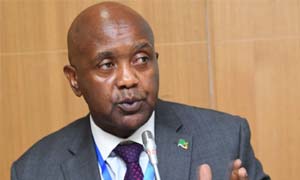ZAMBIA continued on its economic restoration path in the first quarter of 2023, with remarkable progress recorded on the price of copper, the country’s economic mainstay.
Currently, copper is trading around $9,004 from $8 964 in December last year.
The rise in copper prices on the international market has resulted in a positive performance on the Zambia’s local currency which appreciated against major international convertible currencies.
On the country’s inflation rate, January recorded a reduction at 9.4 per cent from 9.9 per cent in December last year.
However, there was a spike on February to 9.6 per cent and March to 9.9 per cent, according to the Zambia Statistics Agency (ZAMSTATS) monthly bulletins.
Statistician general Mulenga Musepa says the rate of inflation increase meant that on average, prices of goods and services increased by 9.9 per cent between March 2022 and March 2023.
On the trade front, the country’s total trade for January 2023 was K35.9 billion compared to that of 2022 for the same period at K27.2 billion representing a 32.2 per cent increase.
For February, the country recorded a trade surplus of K2.8 billion.
The value of exports via all modes of transport for January 2023 was K21.0 billion with the road transport accounting for the highest at K12.5 billion representing K59.4 per cent share.
Zambia recorded a trade surplus of K6.1 billion in January 2023 compared to a deficit of K0.5 billion in December 2022.
“Exports mainly comprising domestically produced goods increased by 42.6 per cent to K21.0 billion in January from K14.7 billion in December 2022. Imports decreased by 1.6 per cent to K14.9 billion in January 2023 from K15.2 billion in December 2022,” says Mr Musepa.
He explains that this is mainly because of decreases on import bills of intermediate goods, capital goods and raw materials respectively.
However, exports for the month of February, mainly comprising domestically produced goods, decreased by 13.8 per cent to K18.1 billion from K21.0 billion in January this year.
This was mainly on account of earnings from intermediate goods, raw materials, consumer and capital goods.
Imports increased by 2.7 per cent to K15.3 billion in February from K14.9 billion in January.
This was mainly due to increases in import bills of capital goods, consumer goods and raw materials.
Other notable activities in the first quarter of 2023 include the release of K15.5 billion by the Government to finance public service delivery.
Of this amount, K5 billion was released for transfers, subsidies and social benefits, while K5.1 billion was spent on debt service (domestic and external) and dismantling of arrears, and K3.6 billion was spent on the public service wage bill.
In addition, the Government released K1.3 billion for implementation of various Government programmes and general operations, while K534.9 million was spent on road infrastructure.
From the K5.1 billion released for debt service and dismantling of arrears, a sum of K2.9 billion went towards both domestic and external debt payments.
From the K5.1 billion, the component related to dismantling of arrears for suppliers of fuel, goods, and services, got K2.2 billion.
Furthermore, the Government released K5 billion towards transfers and subsidies.
Notable expenditure items under this category, included, among others: K2.4 billion to clear invoices related to the procurement of inputs for the 2022/2023 farming season under the Farmer Input Support Programme and K665.5 million for community projects under the Constituency Development Fund (CDF) among others.
The Bankers Association of Zambia (BAZ) has described the country’s 2023 first quarter economic performance as showing a lot of resilience and a continuation on its fiscal restoration path.
BAZ president Leonard Mwanza says in response to a Press query that this is as duly noted by the IMF field mission through the SLA.
“The economic restoration is duly noted by the IMF field mission through the recently issued staff level agreement which painted a positive fiscal restoration process in line with agreed objectives.,” he says.
Mr Mwanza adds that this is further evidenced by the budget credibility and timely
disbursement of funds to programmed activities.
“This is despite head winds occasioned by the abrupt depreciation of the Zambian Kwacha, the short lived loading shedding spell at the beginning of the year, the unresolved debt issue and the threat to single digit inflation, which closed at 9.9 per cent at the end of March due to fuel pump prices and electricity tariff increases, which spiked the general cost of living,” Mr Mwanza explains.
He adds that this is a reflection of the weakness of the Kwacha, which
pushed up the cost of living and in turn reduced the purchasing power
of the ordinary Zambian.
When asked on the performance of the banking sector despite some
challenges, Mr Mwanza also explains that the banking sector has recorded a satisfactory performance in the first quarter of the year.
“In the first quarter, the performance of the banking sector was
satisfactory, with a number of benchmarks above industry thresholds,” he says.
Both international and local factors make up the country’s economic performance and, as indicated in its latest country risk report, Fitch Solutions, a global rating company, Zambia’s Gross Domestic Product (GDP)
growth will remain stable in 2023 as mining exports rebound and
investments in the sector continue to grow.
Fitch has projected Zambia’s economic growth at 3.5 per cent from 3.7 per cent and expects the central bank to cut the policy rate back to nine per cent by end of 2023 as inflation resumes a declining trend after a temporary spike over February-March.








